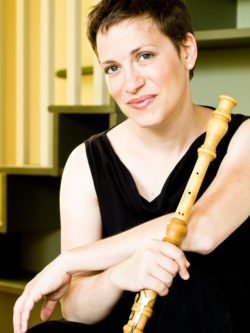by Mike Telin

On Saturday, October 15 at 8:00 pm at SPACES, and on Sunday at 4:00 pm at Herr Chapel, Plymouth Church, Les Délices will kick off its new season with a program titled “Songs Without Words.” The program will feature torch songs spanning the 17th to 20th centuries, including music by Michel Lambert, Marin Marais, Billy Strayhorn, and Nina Simone.
The concept of the program has been on Nagy’s mind since 2005, when she was working on her doctorate. Although she has programmed some of the art songs on previous programs, it was always as an added bon-bon. “I wanted to figure out how to make a compelling full program of this music. When thinking about adapting vocal music to instruments as a way of expanding the repertoire, I began to wonder what other vocal models I could use.”
Nagy’s thought process quickly led her to the Great American Songbook and other songs in the jazz canon. She pointed out that they’ve been adapted by many instrumentalists and were therefore a natural avenue to pursue. Once she began choosing repertoire, Nagy soon realized that she needed some help. She turned to her longtime friend Aidan Plank, a noted local jazz bassist, for advice.
“We’ve known each other since my Oberlin days and we have a strong mutual respect. I told him about my crazy idea, and that I found interesting similarities and parallels between the jazz tunes and the 17th-century art songs. I sent him some recordings and I think he was really struck by them. He responded to their rhythmic flexibility in a serious way. Initially I had made some very safe suggestions, but some of his choices took things a little further outside of the harmonic language than we’re used to. A song I would not have chosen is Billy Strayhorn’s A Flower is a lovesome thing. And Johnny Mandel’s Emily is new to me. I think it’s an absolutely gorgeous ballad that works beautifully as a sarabande. It’s that rare jazz tune in three. The melody is static but the harmonies are like a kaleidoscope around it.”
Nagy pointed out that because of the important role the rhythm section would play, it would be important to have collaborators who would be willing to go outside of their comfort zones. The performers include Debra Nagy, Baroque oboe, Emily Walhout, viola da gamba, and Eric Milnes, harpsichord.
“I’ve known Eric for fifteen years and he has a passion for popular music. He’s adapted a number of 20th-century tunes, specifically the music of The Beatles, for period instruments. He’s also released a couple albums of ‘Beatles Baroque’ which were quite successful, so he has a real love for this. And Emily is always great to work with and has such a flair for bass lines.”
Regarding the art songs that will be included on the program, Nagy said that many were published only as melodies. “You do scratch your head because in our day and age, you can’t imagine performing a melody without some kind of harmonic reinforcement. I did play ‘Rochers je ne veux point’ from Airs et Brunettes a couple of weeks ago without accompaniment, and it was actually very beautiful.”
When asked about her mission to expand the repertoire, Nagy said, “I play Baroque instruments and Baroque music, but I’m still an artist living in the 21st century.”
Published on ClevelandClassical.com October 11, 2016.
Click here for a printable copy of this article



